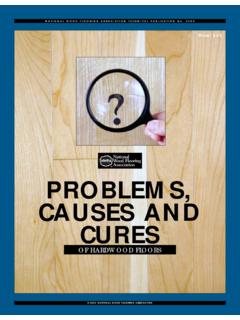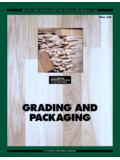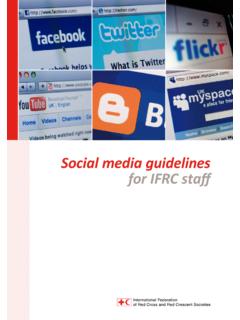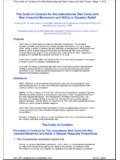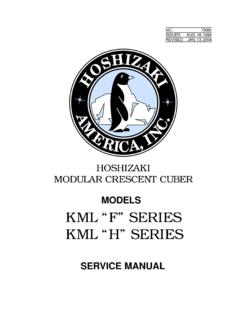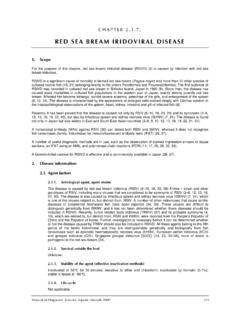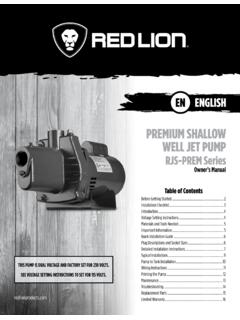Transcription of NOFMA Install Document-2-03 - Crescent Hardwood
1 INSTALLATION MANUALWood Flooring that carries the WFI and/or NOFMA trademark/certifi-cation is a precision-made product of enduring beauty. The ultimateappearance and performance in any application, however, are depen-dent upon the installer and upon close attention to a number of detailsprior to and during the actual installation this manual we have incorporated many years of practical experi-ence to describe the simplest methods of achieving successful installa-tions of various types of oak and other Hardwood information is generally applicable to most Hardwood manufacturers may provide instructions which vary fromthese, particularly in the laying of specialty floorings. Always readand follow the instructions provided by the starting any flooring installation please be sure to read allsections of this you encounter a situation not covered here, or have addition-al questions, we invite you to contact the Technical Department ofNOFMA for assistance.
2 901/526-5016, 8:30 - 4:30 CentralTime, Monday through Friday. NOTE:This brochure covers only the installation meth-ods. Finishing is treated in a separate manual available onrequest from the MANUALNOFMA9 WOOD FLOORINGNOFMA/WFITECHNICALSERVICEHANDLIN G AND Flooring is a quality product made from lumberthat has been kiln-dried. To maintain the moisturelevel, don t truck or unload it in the rain, snow or otherexcessively humid conditions. Cover it with a tarpaulinor vinyl if the atmosphere is foggy or flooring should be stored in an enclosedbuilding that is well ventilated with weather proofwindows and located in areas where similar fine mill-work is stored. The storage area within the buildingshould be clean and dry. Leave adequate room forgood air circulation around stacks of flooring.
3 Con-tinual dry heat may over-dry flooring, which may lat-er result in buckled floors when flooring is deliveredto the job and installed without a proper acclimationor SITE the job site before delivery. Be sure the floor-ing will not be exposed to excessive periods of highhumidity or moisture. The surface grade or slopeshould direct water away from the and crawl spaces must be dry and wellventilated. In joist construction with no basement,outside cross ventilation through vents or other open-ings in the foundation walls must be provided with nodead air areas. A surface cover of 6 mil polyethylenefilm is essential as a vapor retarder in crawl building should be closed in with outside win-dows and doors in place. All concrete, masonry, sheet-rock and framing members, etc. should be thoroughlydry before flooring is delivered to the job site.
4 In warmmonths the building must be well ventilated; duringwinter months heating should be maintained nearoccupancy levels at least five days before the flooringis delivered and until sanding and finishing materials used to provide energy efficientstructures trap moisture in a residence, it may be nec-essary to delay delivery and installation of flooring toallow the excessive moisture trapped duringconstruction to evaporate. The average moisture con-tent of framing members and subflooring should bebelow 12%-14% before delivery of the flooring. Moisturecontents above 12%-14% can cause moisture job site conditions are satisfactory, have theflooring delivered and broken up into small lots andstored in the rooms where it will be installed. Allow4 to 5 days or more, for the flooring to becomeacclimated to job site conditions.
5 If flooring is pack-aged, open or remove packaging for the time flooring is delivered and until occu-pancy, temperature and humidity should be main-tained at or near occupancy levels. After occupancy,continue to control the environment. Extended times(more than 1 month) without HVAC controls can pro-mote elevated moisture conditions which can adverse-ly affect flooring. Protect flooring from excessive heat. Flooringinstalled over a heating plant or un-insulated heatingducts may develop cracks unless protection from theheat is provided. Use a double layer of 15 lb., or asingle layer of 30 lb. asphalt felt/building paper, or 1 2"2 Fig. 1. Plywood-on-slab method of installing strip 2. Screeds method of installing strip flooring on insulation board between joists under theflooring in these areas.
6 Over a heating plant theinsulation used should be OVER A CONCRETE flooring can be installed successfully over aslab which is on-grade or above grade. Below-gradeinstallations are not recommended. The slab must beconstructed properly (dry and flat with a trowel finish).Watch out for water. New concrete is heavy withmoisture, an inherent enemy of wood. Proper on-gradeslab construction requires a vapor retarder such as 6mil polyethylene film between the gravel fill and theslab. While this prevents moisture entry through theslab, this membrane also retards curing of the slab. Sotest for dryness, even if the slab has been in place overtwo years. Slabs younger than 60-days are generallytoo wet for flooring CONCRETE FOREXCESSIVE :Make tests in several areas of eachroom on both old and new slabs.
7 When testsindicate too much moisture in the slab, donot Install Hardwood floors. For a moistslab,wait until it dries naturally, or acceler-ate drying with heat and ventilation thentest The Rubber Mat Test. Lay a smooth, non-corrugat-ed rubber mat on the slab, place a weight on top toprevent moisture from escaping, and allow the mat toremain 24 hours. If the covered area shows watermarks when the mat is removed too much moistureis present. This test is worthless if the slab surface isother than light in color The Polyethylene Film Test. Tape a one-foot squareof 6 mil clear polyethylene film to the slab, sealing alledges with plastic moisture resistant tape. If, after 24hours, there is no clouding or drops of moisture onthe underside of the film, the slab can be considereddry enough to Install wood The Calcium Chloride Test.
8 Place a quarter tea-spoonful of dry (anhydrous) Calcium Chloride crys-tals inside a 3-inch diameter putty ring on the with a glass so the crystals are totally sealedoff from the air. If the crystals dissolve within 12 hoursthe slab is too The Phenolphthalein Test. Put several drops of a3% Phenolphthalein solution in grain alcohol at vari-ous spots on the slab. If a red color develops in a fewminutes, too much moisture is slab must be sound and flat. To prepare the slabgrind off any high spots, fill low spots, clean up grease,oil and other contaminants, and sweep clean. If theslab is mealy and excessively dusty, it may not be ofproper be certain normal slab moisture does not reach thefinished floor, a proper vapor retarder must be usedon top of the slab. Where this is placed will depend onthe type of system used.
9 The vapor retarder should havea perm rating of less than 1 perm. 6 mil polyethy-lene film has a perm rating and is considered a 3 4"plywood used as a nailing base, the recom-mended vapor retarders are affixed to the slab. Thesesystems may be either 2 membrane asphalt felt/buildingpaper and mastic or a 4-6 mil polyethylene film or anequivalent system as described 3. Moisture Retarder using two layers of asphalt feltor building paper. Fig. 4. Wood joist construction using square-edge membrane asphalt felt or building paper and apply cold cut-back asphalt masticwith a notched trowel at the rate of 50 sq. ft per set 2 hours. Roll out 15 lb. asphalt felt/buildingpaper, lapping edges 4". Butt ends. Over this apply asecond similar coating of mastic and roll out a secondlayer of asphalt felt/building paper.
10 Lay both layersof felt in the same direction, but stagger the overlapsto achieve a more even method. When slabs are well abovegrade and the expected annual rainfall is light to mod-erate, cover the entire slab with 4- to 6-mil polyethy-lene film, overlapping edges 4-6" and allowing enoughto extend under the baseboard on all moisture conditions are considered more severe,prime and apply*cold-type cut-back asphalt mastic witha straight-edge or fine tooth trowel over the entire slabsurface (100 sq. ft. per gal.). Allow to dry about 1 the 4-6 mil polyethylene film over the slab, coveringthe entire area and lapping edges 4-6". Walk in or rollin the film, stepping on every square inch of the floor toinsure proper adhesion. Small bubbles are of no concern,and may be punctured to allow captive air to system uses 3 4"or thicker sheathing grade exteriorplywood as the subfloor over the appropriate vapor lay 3 4"plywood panels over entire floor.
